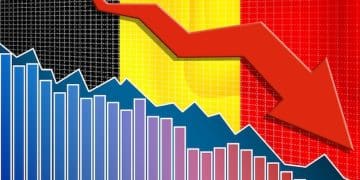Analyzing the US National Debt’s Impact on Economic Stability

Analyzing the effects of the current national debt on future economic stability in the US involves assessing its potential impact on interest rates, inflation, economic growth, and the overall financial health of the nation.
The analyzing the effects of the current national debt on future economic stability in the US is a critical undertaking, given the substantial levels of borrowing and its potential ramifications for generations to come. Understanding the interplay between national debt and economic stability requires an examination of various economic indicators and policy choices.
Understanding the US National Debt
The US national debt represents the total amount of money owed by the federal government to its creditors. Accumulating over decades, it is influenced by government spending, tax revenues, and economic policies.
Understanding the intricacies of the national debt requires examining its components and the factors that contribute to its growth. Let’s delve into these aspects to grasp the scale and nature of the US national debt.
Components of the National Debt
The national debt comprises two main categories: debt held by the public and intragovernmental holdings. Debt held by the public includes Treasury securities purchased by individuals, corporations, foreign governments, and the Federal Reserve. Intragovernmental holdings represent debt owed by the government to its own trust funds, such as Social Security and Medicare.
Factors Contributing to Debt Growth
Several factors contribute to the growth of the national debt, including budget deficits, economic downturns, and fiscal policies. Budget deficits occur when government spending exceeds tax revenues, requiring the government to borrow funds to cover the shortfall. Economic downturns often lead to increased government spending on social safety net programs and decreased tax revenues, further exacerbating deficits.

In summary, understanding the components and factors contributing to the national debt is crucial for assessing its potential impact on future economic stability. Monitoring these aspects can provide insights into the trajectory of the debt and its implications for the economy.
Impact on Interest Rates
A significant effect of the national debt is its influence on interest rates. As the government borrows more, it can drive up borrowing costs for everyone, affecting investment and consumption.
The relationship between national debt and interest rates is complex but pivotal. Higher national debt can lead to increased borrowing costs, impacting various sectors of the economy.
Crowding Out Effect
One potential consequence of a large national debt is the crowding out effect. When the government borrows heavily, it competes with private sector borrowers for available funds. This increased demand for funds can drive up interest rates, making it more expensive for businesses and individuals to borrow money.
Inflation Expectations
A high national debt can also influence inflation expectations. If investors and consumers believe that the government will resort to inflationary policies to reduce the real value of the debt, they may demand higher interest rates to compensate for the expected erosion of purchasing power. This can lead to a self-fulfilling prophecy, where rising inflation expectations drive up interest rates, further increasing the cost of borrowing.
- Higher interest rates can discourage business investment and reduce economic growth.
- Increased borrowing costs can make it more difficult for individuals to purchase homes or finance other large purchases.
- Rising interest rates can lead to higher debt servicing costs for the government, further increasing the national debt.
In conclusion, the impact of national debt on interest rates can have far-reaching consequences for the economy. Managing the debt effectively is essential for maintaining stable interest rates and fostering sustainable economic growth.
Effects on Inflation
The national debt can also have a significant impact on inflation. Excessive borrowing can lead to an increase in the money supply, potentially devaluing the currency and raising prices.
Analyzing the relationship between national debt and inflation is crucial for understanding the broader economic effects. High levels of debt can contribute to inflationary pressures.
Monetary Policy Responses
In some cases, governments may attempt to monetize the debt by instructing the central bank to purchase government bonds. This can increase the money supply, leading to inflation if the money supply grows faster than the economy’s productive capacity.
Fiscal Stimulus
Large-scale fiscal stimulus packages, often financed by borrowing, can also contribute to inflation. If these stimulus measures inject too much money into the economy too quickly, they can create excess demand, leading to higher prices.

In summary, the national debt can influence inflation through various channels, including monetary policy responses and fiscal stimulus measures. Monitoring these factors and implementing appropriate policies is crucial for maintaining price stability.
Impact on Economic Growth
The long-term effects of national debt on economic growth are a subject of debate among economists. While some argue that borrowing can stimulate short-term growth, others caution about the long-term consequences.
The relationship between national debt and economic growth is complex and multifaceted. High levels of debt can have both short-term and long-term effects on economic expansion.
Reduced Public Investment
As debt servicing costs rise, governments may be forced to reduce public investment in essential areas such as infrastructure, education, and research and development. This can hinder long-term economic growth by reducing productivity and innovation.
Increased Uncertainty
A high national debt can create uncertainty about future tax policies and government spending. This uncertainty can discourage business investment and hiring, as firms become hesitant to commit resources in an environment of fiscal instability.
- High debt levels can lead to higher taxes in the future, reducing disposable income and consumer spending.
- Increased government borrowing can crowd out private investment, leading to lower overall investment levels.
- A large national debt can make a country more vulnerable to economic shocks, as investors may become wary of lending to a heavily indebted nation.
In conclusion, the impact of national debt on economic growth can be complex and far-reaching. Managing the debt effectively is essential for fostering sustainable economic growth and prosperity.
Global Implications
The US national debt has implications beyond its borders. As the world’s largest economy, the fiscal health of the United States can affect global financial markets and trade relationships.
Analyzing the global implications of the US national debt is crucial for understanding its broader impact on the international economy. The fiscal health of the US can have ripple effects worldwide.
Impact on Global Interest Rates
The US Treasury market is a benchmark for global interest rates. Changes in US borrowing can influence interest rates in other countries, affecting their economic conditions.
Currency Valuation
A high national debt can put downward pressure on the value of the US dollar. This can affect the competitiveness of US exports and the cost of imports.
Monitoring the global implications of the US national debt is crucial for understanding its broader significance and potential ripple effects on the international economy.
Strategies for Managing the National Debt
Addressing the national debt requires a comprehensive approach involving fiscal policies, economic reforms, and responsible budgeting.
Effective management of the national debt requires a combination of strategies aimed at controlling spending, increasing revenue, and promoting economic growth.
Fiscal Consolidation
Fiscal consolidation involves reducing government spending and increasing tax revenues to narrow the budget deficit. This can be achieved through spending cuts, tax increases, or a combination of both.
Economic Growth Policies
Policies that promote sustainable economic growth can help increase tax revenues and reduce the debt-to-GDP ratio. These policies may include investments in education, infrastructure, and research and development.
- Implementing structural reforms to improve productivity and competitiveness.
- Diversifying the economy to reduce reliance on debt-fueled consumption.
- Promoting responsible budgeting and fiscal transparency.
In summary, managing the national debt requires a multifaceted approach involving fiscal consolidation, economic growth policies, and responsible budgeting. By implementing these strategies, the US can work towards a more sustainable fiscal future.
| Key Point | Brief Description |
|---|---|
| 📈 Debt & Interest | Higher debt can increase interest rates, affecting borrowing costs. |
| 💰 Debt & Inflation | Excessive debt may lead to increased inflation through monetary policies. |
| 🌱 Debt & Growth | High debt can hinder long-term economic growth due to reduced investment. |
| 🌍 Global Impact | US debt levels can affect global financial stability and interest rates. |
FAQ
▼
The US national debt is the total amount of money the US federal government owes to its creditors. It accumulates over time due to budget deficits.
▼
A high national debt can lead to increased borrowing by the government, potentially driving up interest rates for everyone, including businesses and consumers.
▼
Yes, if the government resorts to increasing the money supply to manage the debt, it can devalue the currency and result in higher prices.
▼
High national debt can reduce public investment in essential sectors such as infrastructure and education, hindering long-term economic growth and innovation.
▼
Strategies include fiscal consolidation (reducing spending and increasing taxes), promoting economic growth, and ensuring responsible budgeting practices.
Conclusion
In conclusion, analyzing the effects of the current national debt on future economic stability in the US is critical for understanding its potential impact on interest rates, inflation, economic growth, and global financial markets. Effective management of the debt through fiscal consolidation, economic growth policies, and responsible budgeting is essential for ensuring a sustainable fiscal future for the United States.






